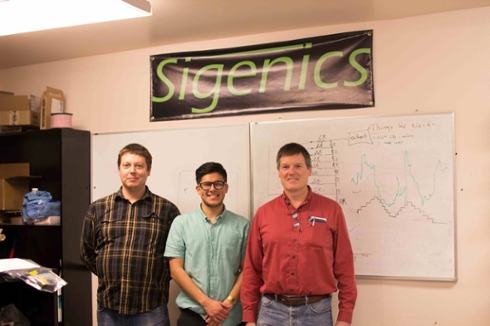Insights at Sigenics, Winter Externship, Edgar Perez

This winter, two fellow Reedies and I had an amazing experience working with Dr. Doulas Kerns and Mr. Marcus Snyder at Sigenics. Together, they provided an empowering three day externship and enlightening insights as to the life of electrical engineers. We started our trip with an hour long commute from the California coast to the base of Mt. San Antonio. Relieved from traffic by the carpool lane and good music, our trip to Sigenics was always pleasurable.
We spent our first day learning about the company and the different roles of scientists and engineers. Dr. Kerns started off with a small tour of their lab and showed us some of their designs. He really blew us away when he showed us the incredibly small size of their circuit designs and their circuit elements. A chip no bigger than 1 squared millimeter can house billions of transistors. As if hearing about this wasn’t enough, Dr. Kerns pulled out a sample of their work and placed it under and a powerful microscope. There is was. Mind-numbing in scale and constructed with jaw-dropping precision. Millions of components carefully embedded in a tiny silicon chip, and the chip: even more precisely designed. Yet here we were, three unexperienced undergrads sharing a room with the chip designers themselves!
The relationship between an engineer and a scientist was the next item on Dr. Kern’s agenda. Using a very Reed-esque analogy of a pizza shop, he demystified some of the quirks of engineering. The relationship between engineers and scientists is actually more symbiotic in nature than one would expect, he explained. Engineers use scientific results to develop tools for scientists. In turn, scientists use the tools to develop new results. This is relationship is a vertical growth pattern where the two fields help propel one another. Along the way, the tools and results produced by both parties will spread horizontally, manifesting themselves as new technologies or constructions for the benefit of our societies. We ended the day with a scientific investigation of the phenomena occurring “behind the scenes” in the electrical components we used the following day, and (appropriately) some delicious pizza from a local shop.
The second and third days, Marcus gave us hands on training on building tools for our own experiments. The primary vehicles for this were introductions to Arduino development and basic computer programming. We started out with very basic circuits that did things like dim an LED based on the resistance of a potentiometer, but by the end of the externship we had built our own (simplified) waveform generator and an infrared light sensor. Each project was a powerful demonstration of the utility (and ease!) of building tools for scientific exploration. Being at Reed, it is often easy to get lost in the theory of our sciences, so seeing our ideas materialize into tangible tools in only a couple of days was an empowering experience. To top that off, Sigenics even gifted us our very own Arduino module to bring back to Reed and keep developing the invaluable skills we learned in their lab.
The time we spent at Sigenics was an invaluable investment to my life beyond Reed. As an aspiring Electrical Engineer, the externship provided a sneak peek into my future, full of insights and valuable information that simply does not exist within the classroom setting. I look forward to continuing my exploration of electronics with the tools that Sigenics provided me and can’t imagine a better way to have spent my time back home.
Tags: sigenics, circuit design, circuit , electronics, engineering, externship, winter externship
